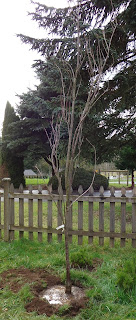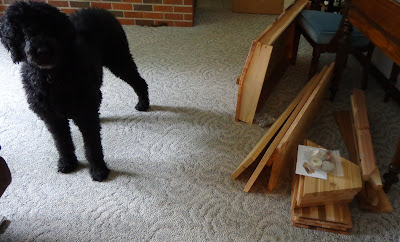I saw this grape variety at the local "Everything Store". Remembering,
Buffalo is considered a Concord-like grape that bears in this cool summer area, unlike Concord. The plant looked OK, so I bought it and planted it today. Other plants in the grape / kiwi row have been harassed by moles, so I planted in a chicken wire basket.
WA State extension lists these grapes as potential table grapes for this area:
Buffalo – midseason Concord type, blue
Canadice – early pinkish red (I have Canadice, the grapes are small and I'm not crazy about the taste)
Interlaken Seedless – early white, vigorous (I have Interlaken, I like this one)
Jupiter – early, blue, large berries
Lynden Blue – very early blue, seeded
Mars – medium early, blue
Neptune – medium early, white
Reliance – early, red, table and juice
Saturn – medium early, red
Van Buren – blue Concord type, early
Vanessa – early red
Venus – early red (I think this is wrong. I have Venus, it's good but they are blue. I like Concord-type grapes better)
NY 78.836.06 – selection from Geneva, NY breeding program
I also planted these
Anemones. I've read that anemones are both deer and rabbit resistant. After reading that Muscari are deer resistant, I planted quite a few this winter. Rabbits have eaten them all off. I'm guessing it's rabbits. We'll see what they think of Anemones. Soaked for 2 hours per label instructions, and planted in the tree circles.
 Pontiac Red potatoes. Bought seed potatoes at Fred Meyer garden section. Cut them apart for separate eyes. Let them dry out for 2 days. This potting soil contained beans last year.
Pontiac Red potatoes. Bought seed potatoes at Fred Meyer garden section. Cut them apart for separate eyes. Let them dry out for 2 days. This potting soil contained beans last year.
 Smaller diameter container. These are "White gourmet" potatoes. I obtained the starts 2 or 3 years ago, also Fred Meyer. They grow well in containers. These starts were in the basement, already grew 3 or 4 inches. I just cut them apart today.
Smaller diameter container. These are "White gourmet" potatoes. I obtained the starts 2 or 3 years ago, also Fred Meyer. They grow well in containers. These starts were in the basement, already grew 3 or 4 inches. I just cut them apart today. They don't look like much. Covered with a few inches of potting soil. When the leaves are a foot high, I'll add 6 inches of potting soil, and again when another 6 inches higher, until mid summer. I could have planted in raised beds but no room. No ground prepared either. This method is very easy and productive. The wider green container is a better choice, more room.
They don't look like much. Covered with a few inches of potting soil. When the leaves are a foot high, I'll add 6 inches of potting soil, and again when another 6 inches higher, until mid summer. I could have planted in raised beds but no room. No ground prepared either. This method is very easy and productive. The wider green container is a better choice, more room.




























